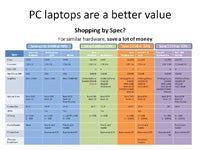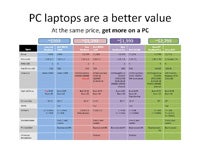Microsoft and Windows Vista have taken quite the shellacking from Apple via the latter’s “I’m a Mac, I’m a PC” ads. The Redmond software giant has attempted to hit back, with varying degrees of success. Now the company is moving forward with something less formal than its “Project Mojave” ads touting Vista.
Microsoft (NASDAQ: MSFT) first made its “Apple Tax” argument last October, just in time for the new MacBooks. The basic claim is that Mac buyers pay far more (a tax if you will) for their systems than comparably equipped PCs.
With Macworld Expo running this week, Microsoft is once again making the effort, not as coordinated or as forceful as the “Project Mojave” ads, which showed consumer surprised to see that Vista wasn’t the steaming pile they thought it was.
The main point of the Apple Tax effort is to point out that under the gloss of Apple’s (NASDAQ: AAPL) beautifully designed notebooks that they are, in the end, a PC notebook using the same parts found in laptops from HP, Dell and Lenovo, but costing a great deal more. Microsoft makes the same comparison to PC desktops versus Apple’s more expensive systems. Microsoft detailed the Apple Tax in a document forwarded to various tech media including InternetNews.com.
Macs are generally lauded for their ease of use, something you can’t necessarily price and which Microsoft didn’t address.
“You’ll pay as much as $300 more for an iMac machine that offers fewer innovations (i.e. Blu-Ray, e-SATA, HDMI and media card readers) than some of the best Windows-based desktops on the market. The Apple Tax premium is even more significant at the Mac Pro level, where you’ll find price premiums as high at $1700 more for the Mac Pro,” Microsoft said in the “Apple Tax” document it is distributing.
Apple could not be reached for comment by press time.
 Click on the graphic for a larger view. Source: Microsoft |
The company argues there are hidden costs of the Apple Tax for applications that run on a Mac, as well. “It’s more expensive to replace your applications on a Mac and more difficult to find applications that work with a Mac. There are over 11,000 applications that run on Windows PCs today. Less than 25% of all applications at retail are available for the Mac,” it said, citing a NPD Group Retail Tracking Service report.
Accompanying the talking points are graphical charts showing that the PC side of the market has products with similar or better features than on the Mac for significantly less money.
Microsoft admits it’s had enough FUD for now. “In the last few years, they’ve spent a lot of time and money telling our customers what to think of our product, and we’re tired of that. We just want people to think about what Apple has been saying. We want people to understand there’s more that goes into a laptop,” Jay Paulus, director of the Windows business group told InternetNews.com.
Next page: Not avoiding Vista?
Page 2 of 2
 Click on the graphic for a larger view. Source: Microsoft |
Not avoiding Vista?
The “Apple Tax” isn’t a formal campaign, nor is it being run in conjunction with the hardware OEMs that are being used to draw distinctions between the two companies. Paulus acknowledged that the OEMs took a pass on the initiative. Also absent from the tax chart is any mention of the operating system, but Paulus said that’s not to downplay Vista.
“We’re not actively avoiding Vista,” he said. “The progress we’ve made on that product is incredible. No doubt we made some mistakes on that thing. We made architectural changes late in the development cycle that didn’t have time to settle before release. I would argue that the majority of those issues have rippled out of the system.”
But using partners, however close, could backfire on Microsoft, warns IDC analyst Richard Shim. “It may not be a big favor to their hardware partners considering Microsoft doesn’t have skin in the game to pick a hardware fight with Apple. Indirectly, it could hurt them, depending on how hard they push it,” he told InternetNews.com.
Shim also wonders how effective the campaign can be, since it’s pretty well-known that Apple sells an expensive product. “The impression you could get is all Windows systems are really cheap. Essentially what you are doing is saying Apple is a premium product and you buy them when you can afford one, and if you can’t do that, you buy these PCs, and that’s a danger. OEMs don’t want to be viewed as not being as good as Apple,” he said.


